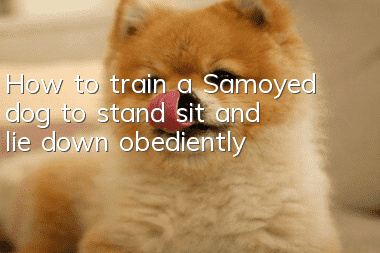How to train a Samoyed dog to stand, sit and lie down obediently

The Samoyed dog has a noble image because of its alertness, strength, flexibility, beauty and noble appearance. Nowadays, more and more people like to keep cute Samoyed dogs as their pets. But if you want to have a well-behaved and obedient Samoyed dog, you need to get it through acquired training. So next I will introduce to you how to train a Samoyed dog. How to train a Samoyed dog to stand, sit, and lie down? The training of standing, sitting, and lying down begins. At this time, although the Samoyed dog is trained to stand, sit, and lie down separately, the Samoyed dog often connects these three independent subjects. Do. Therefore, each movement must be trained separately in detail, and these movements must be combined and trained in various ways. Diversified training not only prevents Samoyed dogs from feeling monotonous and bored, but also allows Samoyed dogs to concentrate and increase their excitement. In the early stage of training, the requirements for Samoyed dogs should not be too high. Just keep each action for 3-5 seconds every day. Generally train twice a day. 5-10 minutes each time. The training goals for young Samoyed dogs are: the Samoyed dog can maintain the three movements of standing, sitting and lying down for 15-30 seconds each, and can follow the dog on a leash, and the pet owner can call it to come. When training upright movements, you should train in a relatively quiet environment so that the Samoyed dog can concentrate. The pet owner's face should be expressive and his voice should be soft and pleasant. If you suddenly stare, push or pull the dog, the dog will think that it has done something wrong. Training essentials: First, let the Samoyed dog sit in front of the owner, with its head facing the right elbow and its tail to the left of the owner. Then the pet owner grabs the top or side of the collar with his right hand, and at the same time puts his left hand under the Samoyed's belly and leans on the hind legs, with the palm of his hand facing down, calls the Samoyed's name and gives the "stand" command (with a long tone) ). When the "stand" command is given, gently lift the collar forward and touch the Samoyed's hind legs to make the Samoyed stand (do not hit the Samoyed's legs, just touch its legs gently, and do not pull the Samoyed hard). Maya dog standing). When the dog stands, the left one is still in place to keep the dog in a standing position. It is best to keep the dog standing for a few seconds at a time. When training a large Samoyed, place your left arm under the Samoyed's belly and touch its hind legs with your palm. If the Samoyed wants to move, you can use your palm to control the Samoyed from the side to keep it in the correct position. Give one or more "stand" commands and let the Samoyed dog remain standing for a period of time. Use your right hand to give gesture instructions to the Samoyed, with the fingers of your right hand close together, and the hand is often about 10 cm away from the Samoyed's face. When the "stand" command is given, quickly raise your hand 3-6 cm away from the face. If it touches the Samoyed's face, do not stop. Regardless of whether you use a command or gesture to command the Samoyed to "stand", your left hand should remain in the original position and try to make the Samoyed stand for a few seconds. After the Samoyed dog stands in obedience to the command, it must be rewarded. The sitting action is to start training in a standing position, with the Samoyed dog's head facing the owner's right elbow, the owner's right hand holding the collar, and the left hand still placed on the position when training to stand. on the basis of,First remove your left hand, call the Samoyed's name and give the "sit" command. At the same time, gently pull the collar upwards and back with your right hand, and push the Samoyed's hind legs and knees with your left hand to make the Samoyed sit down. The movements should be light and smooth, and do not push hard to avoid breaking the Samoyed's legs. When the Samoyed dog sits up, give the delay command and gestures. If the dog has done well, reward it fully and gently stroke the dog to eliminate its fear and fully relax it. Lying is introduced from the sitting position. Although Samoyed dogs usually like to lie down, they don’t like to be forced to lie in one position. It is not easy to get the Samoyed dog to extend its two forelimbs forward from the bottom of the body in a standardized manner when lying down, and to maintain this posture. The training steps are as follows: Step 1: Let the Samoyed dog relax first, so that it will be easier to train lying down. During training, put the puppy on the table. The owner's left arm goes around the Samoyed's back, raises one front leg a few centimeters and shakes it up and down. If the Samoyed cooperates, praise it, and then gently lower the leg. , use your right hand to lift the other leg to do the same shaking, and praise it. The purpose is not to instill fear in the Samoyed. Step 2: Lift both legs at the same time and rock them back and forth to relax. Step 3: Based on the second step, call the Samoyed dog's name and give the command "Lie", then gently stretch the foot forward until it is in the appropriate position, put it down, and then reward it. Large Samoyed dogs should be trained on the ground, with the Samoyed dog sitting sideways in front and close to the owner's body, which will help control the Samoyed dog's rotation. The pet owner grabs the collar with his right hand, and grabs the forelimbs with his left hand over his back. He lifts the two limbs and shakes them up and down to relax them. He praises and shakes his legs at the same time, so that the Samoyed dog is less likely to be frightened. He keeps shaking until the Samoyed dog relaxes. Then the left arm goes around the Samoyed, and the elbow is placed on the Samoyed's hip, so that the Samoyed is in a lying state. During the process of putting down the forelimbs, continue to shake the forelimbs and call the Samoyed dog while giving the command "Lie". When the Samoyed dog lies down, take your left hand away from the Samoyed dog's back, gently give the Samoyed dog the "Lie-" delay command and gesture. The command voice should be gentle so that the Samoyed dog is not eager to get up. It is enough to train the Samoyed dog to stay lying down for 3-5 seconds. The goal of this stage is that the Samoyed can lie down quickly as soon as it hears the command without help. When necessary, you can give the "Lie" delay command or gesture to allow the Samoyed to continue lying down. As long as the methods introduced above are mastered well and applied properly, good training results can be achieved. During training, do not use the method of rotating and pressing the dog's head to make the dog lie down. In this way, the dog will not only refuse, but also feel resentful and helpless. Try to create a relaxed environment for the dog to lie down. This stage of transition training between standing, sitting and lying down mainly trains Samoyed dogs to transition between standing, sitting and lying down. This is a very important basic training. It needs to be based on all training movements being in place. The key to getting the Samoyed right is to focus the dog. Start letting SatsumaThe dog sits, stands, sits in order, then sits, lies, sits, and finally reaches sit, lie, and stand. When various movements change, the time of repeated training should not be too long, because the attention of young dogs is limited, and the training time will be too long, which will make the dogs bored. If the pet owner needs the puppy to maintain a certain posture, he can give the Samoyed an auxiliary delay command between the sit, stand or lie down commands until the puppy can complete it well before abandoning it. Don't rush your training, make sure there's time between commands, and don't change commands too quickly or chain them together. The trainer should give commands slowly and speak clearly. Finally, don’t forget that when the Samoyed dog can complete the actions required by the pet owner, it must be fully rewarded. When the young Samoyed dog performs the trained actions well, pet owners often want to speed up the training. If you really want to minimize the prompts, you should take some time to let the young Samoyed forget those special "helps". It is best to gradually stop using redundant auxiliary commands or actions. If these auxiliary commands and actions continue for too long, it is possible that Confusing the Samoyed.
Random articles
- The importance of purebred dog pedigree certificates
- How to identify the authenticity of a pedigree certificate
- When does Husky shed hair? What should you do if your dog sheds hair easily in spring?
- How to avoid walking your dog into walking your dog?
- How to solve the problem of body odor in pet dogs?
- Dogs that don’t shed, say goodbye to the sadness of losing hair during the changing seasons
- How to feed a puppy that is several months old? What are the precautions for feeding puppies?
- How dogs can prevent colds and effectively fight the flu season
- What to do if your pet dog is losing hair
- Dogs with colds and coughs may have kennel cough. Do you know about kennel cough?



